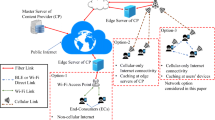Abstract
Satisfying the increasing demand for high data rates has become a main challenge for cellular network operators. Moreover, the demand for video traffic in cellular networks has been continuously increasing. In 2016, wireless video accounted for more than half of the total mobile data traffic, and it is expected to further increase in the upcoming years. This will increase the amount of data to be transmitted in cellular networks, and further increase the challenge for cellular network operators. Device-to-Device (D2D) communication, introduced by the Long Term Evolution-Advanced (LTE-A) standard, is a new communication technique that allows direct communication between devices in cellular networks without going through the Base-Station (BS). We present two algorithms for improving the throughput of video transmission in cellular networks. The algorithms are called Cached and Segmented Video Download (CSVD), and DIStributed, Cached, and Segmented video download (DISCS). The algorithms send segments of video files to selected User Equipments (UEs) in the cellular network, to cache and forward them to requesting UEs using D2D communication. We study the performance of both algorithms analytically in terms of the hit ratio. Furthermore, we use the Discrete EVent System Specification (DEVS) formalism to build an LTE-A network model and use the model to study the performance of CSVD and DISCS in terms of the cell’s aggregate data rate as well as the average data rate. Simulation results show that CSVD and DISCS achieve significant performance improvements in terms of the aggregate and average data rates.
















Similar content being viewed by others
References
ICT Data and Statistics Division, Telecommunication Development Bureau, ITU (2016) ICT facts and figures. Tech. rep. https://www.itu.int/en/ITU-D/Statistics/Documents/facts/ICTFactsFigures2015.pdf
Cisco (2017) Cisco visual networking index: global mobile data traffic forecast update. Tech. rep. http://www.cisco.com/c/en/us/solutions/collateral/service-provider/visual-networking-index-vni/mobile-white-paper-c11-520862.html
Parkvall S, Astely D (2006) The evolution of LTE towards IMT-advanced. J Commun 4(3):146–154
Asadi A, Wang Q, Mancuso V (2014) A survey on device-to-device communication in cellular networks. IEEE Communications Surveys and Tutorials 16(4):1801–1819
Kaufman B, Aazhang B (2008) Cellular networks with an overlaid device to device network. In: Proceedings of Asilomar Conference on Signals, Systems and Computers, pp 1537–1541
Doppler K, Rinne MP, Wijting C (2009) Device-to-device communication as an underlay to LTE-advanced networks. IEEE Commun Mag 47(12):42–49
Doppler K, Rinne MP, Janis P (2009) Device-to-device communications: functional prospects for LTE-Advanced networks. In: Proceedings of IEEE ICC Workshops, pp 1–6
Al-Habashna A, Wainer G, Boudreau G, Casselman R (2015) Improving wireless video transmission in cellular networks using D2D communication. Provisional patent P47111
Al-Habashna A, Wainer G, Boudreau G, Casselman R (2016) Cached and segmented video download for wireless video transmission. In: proceedings of the 49th ANSS, pp. 18–25
Al-Habashna A, Wainer G, Boudreau G, Casselman R (2016) Distributed cached and segmented video download for video transmission in cellular networks. In SPECTS'16, pp. 473–480
Golrezaei N, Mansourifard P, Molisch AF, Dimakis AG (2014) Base-station assisted device-to-device communications for high-throughput wireless video networks. IEEE Trans Wirel Commun 13(7):3665–3676
Zeigler B, Praehofer H, Kim T (2009) Theory of modeling and simulation. Academic Press, San Diego
Wainer G (2009) Discrete-event modeling and simulation: a practitioner's approach. CRC/Taylor & Francis Group, Boca Raton
Chandrasekhar V, Andrews J, Gatherer A (2008) Femtocell networks: a survey. IEEE Commun Mag 46(9):59–67
Ahlehagh H, Dey S (2012) Hierarchical video caching in wireless cloud: Approaches and algorithms. In: Proceedings of IEEE ICC, pp 7082–7087
Chellouche SA, Négru D, Chen Y (2012) Home-box-assisted content delivery network for Internet video-on-demand services. In: Proceedings of IEEE ISCC, pp 544–550
Maddah-Ali MA, Niesen U (2015) Decentralized caching attains orderoptimal memory-rate tradeoff. IEEE/ACM Trans Networking 23(4):1029–1040
Zhao J, Zhang P, Cao G (2010) Cooperative caching in wireless P2P networks: design, implementation, and evaluation. IEEE Trans on parallel and distributed systems 21(2):229–241
Zhang Y, Song L, Saad W, Dawy Z, Han Z (2015) Contract-based incentive mechanisms for device-to-device communications in cellular networks. IEEE JSAC 33(10):1–12
Gao L, Huang J, Chen Y, Shou B (2014) Cooperative spectrum sharing: a contract-based approach. IEEE Trans Mob Comput 13(1):174–187
Duan L, Kubo T, Sugiyama K, Huang J, Hasegawa T, Walrand J (2014) Motivating smartphone collaboration in data acquisition and distributed computing. IEEE Trans Mob Comput 13(10):2320–2333
Kang HJ, Park KY, Cho K (2014) Mobile caching policies for device-to-device (D2D) content delivery networking. In: INFOCOM WKSHPS, pp 299–304
Keller L, Le A, Cici B, Seferoglu H, Fragouli C, Markopoulou A (2012) MicroCast: cooperative video streaming on smartphones. In: proceedings of MobiSys, pp 57–70
Eittenberger P, Herbst M, Krieger U (2012) RapidStream: P2P streaming on android. In: proceedings of IEEE International Packet Video Workshop, pp 125–130
Siris V, Dimopoulos D (2015) Multi-source mobile video streaming with proactive caching and D2D communication. In: IEEE WoWMoM, pp 1–6
[3GPP] TR36.942 (2015) Evolved universal terrestrial radio access; RF system scenarios. Tech. rep
Al-Hourani A, Chandrasekharan S, Kandeepan S (2014) Path loss study for millimeter wave device-to-device communications in urban environment. In: Proceedings of IEEE ICC, pp 102–107
Cha M, Kwak H, Rodriguez P, Ahn Y, Moon S (2007) I tube, you tube, everybody tubes: analyzing the world’s largest user generated content video system. In Proceedings of ACM SIGCOMM conference on Internet measurement, pp 1–14
Ahsan S, Singh V, Ott J (2014) Characterizing internet video for large-scale active measurements. arXiv preprint arXiv:1408.5777v1
Acknowledgements
The authors would like to thank Gary Boudreau and Ronald Casselman from Ericsson Canada for their valuable assistance during this work.
Author information
Authors and Affiliations
Corresponding author
Rights and permissions
About this article
Cite this article
Al-Habashna, A., Wainer, G. Improving Video Transmission in Cellular Networks with Cached and Segmented Video Download Algorithms. Mobile Netw Appl 23, 543–559 (2018). https://doi.org/10.1007/s11036-017-0906-x
Published:
Issue Date:
DOI: https://doi.org/10.1007/s11036-017-0906-x




